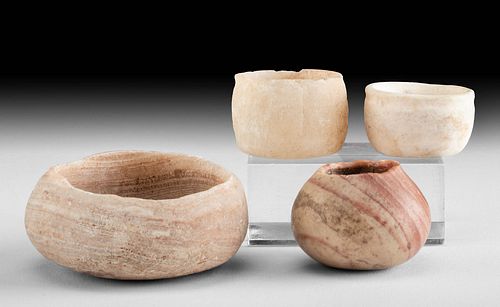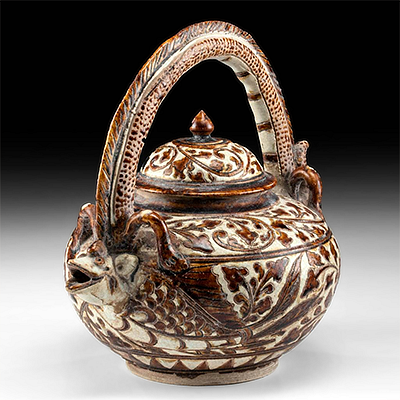4 Egyptian Old Kingdom Alabaster Vessels - Jars & Bowl
Lot 13
About Seller
Artemis Fine Arts
686 S Taylor Ave, Ste 106
Louisville, CO 80027
United States
Selling antiquities, ancient and ethnographic art online since 1993, Artemis Gallery specializes in Classical Antiquities (Egyptian, Greek, Roman, Near Eastern), Asian, Pre-Columbian, African / Tribal / Oceanographic art. Our extensive inventory includes pottery, stone, metal, wood, glass and textil...Read more
Categories
Estimate:
$1,200 - $1,800
Absentee vs Live bid
Two ways to bid:
- Leave a max absentee bid and the platform will bid on your behalf up to your maximum bid during the live auction.
- Bid live during the auction and your bids will be submitted real-time to the auctioneer.
Bid Increments
| Price | Bid Increment |
|---|---|
| $0 | $25 |
| $300 | $50 |
| $1,000 | $100 |
| $2,000 | $250 |
| $5,000 | $500 |
| $10,000 | $1,000 |
| $20,000 | $2,500 |
| $50,000 | $5,000 |
| $100,000 | $10,000 |
| $200,000 | $20,000 |
About Auction
By Artemis Fine Arts
Jul 1, 2021
Set Reminder
2021-07-01 10:00:00
2021-07-01 10:00:00
America/New_York
Bidsquare
Bidsquare : Antiquities | Asian | Ethnographic Art
https://www.bidsquare.com/auctions/artemis-gallery/antiquities-asian-ethnographic-art-7148
Featuring classical antiquities, ancient and ethnographic art from cultures encompassing the globe. Egyptian, Greek, Roman, Near Eastern, Asian, Pre-Columbian, Native American, African / Tribal, Oceanic, Spanish Colonial, Russian, Fossils, Fine Art, more! All legally acquired, legal to sell. Artemis Fine Arts info@artemisfinearts.com
Featuring classical antiquities, ancient and ethnographic art from cultures encompassing the globe. Egyptian, Greek, Roman, Near Eastern, Asian, Pre-Columbian, Native American, African / Tribal, Oceanic, Spanish Colonial, Russian, Fossils, Fine Art, more! All legally acquired, legal to sell. Artemis Fine Arts info@artemisfinearts.com
- Lot Description
Ancient Egypt, Old Kingdom, 3rd to 6th Dynasty, ca. 2686 to 2181 BCE. A fine collection of four vessels hand-carved from alabaster. The largest is a squat bowl with thick walls and a wide rim surrounding the interior basin. The bowl may have been an offering vessel for a shrine or for the deceased, and the stone is an attractive pink and beige hue. The three other vessels are petite jars with openings that are just large enough for a finger to be inserted. These may have been used for holding kohl or other cosmetics meant to be applied to the eyelids with a finger or applicator stick. Alabaster was a prized for its lustrous surface as well as its banded coloring; the stones illuminate when held to a light despite their opaque appearance. These cosmetic vessels were probably owned by an elite or wealthy member of ancient Egyptian society; a lovely collection! Size of largest bowl: 2.25" Diameter x 1" H (5.7 cm x 2.5 cm); smallest: 1.25" Diameter x 0.75" H (3.2 cm x 1.9 cm)
Alabaster, which is a form of gypsum or calcite, soft to carve and smooth, was quarried along the length of the Nile, from Giza to just south of Luxor, and the Egyptians made its carved forms famous throughout the ancient world. A thousand years later, the Greeks made vessels like this out of pottery and painted them white in imitation of the beautiful stone.
Provenance: private Corpus Christi, Texas, USA estate collection, acquired 1960s to 1970s
All items legal to buy/sell under U.S. Statute covering cultural patrimony Code 2600, CHAPTER 14, and are guaranteed to be as described or your money back.
A Certificate of Authenticity will accompany all winning bids.
We ship worldwide and handle all shipping in-house for your convenience.
#165291Chips to rim of largest bowl and abrasions and chips to base. Nicks and chips to rims of other bowls. Smallest has old inventory label on base. Otherwise intact with light surface abrasions and mineral deposits on all.Condition
- Shipping Info
-
All shipping is handled in-house for your convenience. Your invoice from Artemis Gallery will include shipping calculation instructions. If in doubt, please inquire BEFORE bidding for estimated shipping costs for individual items.
-
- Buyer's Premium



 EUR
EUR CAD
CAD AUD
AUD GBP
GBP MXN
MXN HKD
HKD CNY
CNY MYR
MYR SEK
SEK SGD
SGD CHF
CHF THB
THB















